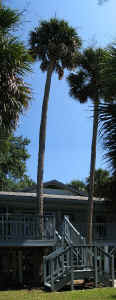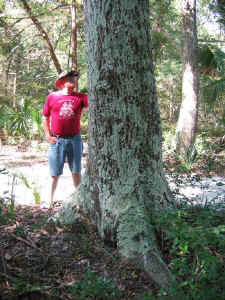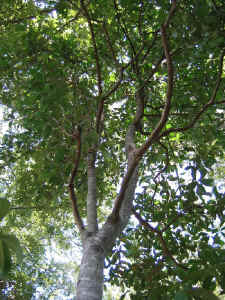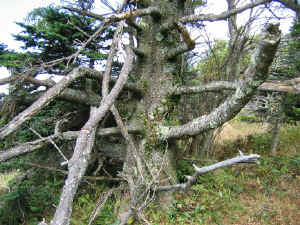ENTS
et al,
The past three weeks have found me traversing varied forests
from the
highest peak in the east (Mount Mitchell, 6684') to Edisto
Island, SC (A
touch above sea level). Ironically, one native tree species was
held in
common with the two sites, and I will open the floor to guesses
as to what
it may be (hint, it is NOT live oak;).

Edisto Nature Trail
|
My family rented a house on Edisto Island, SC for the week of
10/19-25th.
Before I left the house I grabbed my latest SC State Champion
Tree list to
see what trees I may have the opportunity to visit. Two were
literally on
the highway; co-champion bottomland post oaks (Quercus similis).
I was not
able to stop to measure them on the highway median but with more
personal
experience with them, they just may become my favorite oak
species. They are
SUPER gnarly trees with a "Gnarlage Factor" off the
scale! In fact, most of
the coastal forests have high GF due to hurricanes and salt
spray. The
coastal forests of live oak draped in Spanish moss are so
beautiful they
almost defy description. (However, I can attest the beauty wears
off a
little the next day after visiting these forests when the
chiggers erupt in
full, unabated itch!)

Current SC State Champion palmetto
|

59'sabal palm on Jungle Shores Road
|
As it turns out, the house we rented was just 8 blocks from the
state
champion sabal palm (Sabal palmetto). It was listed as 50' tall-
a figure I
was skeptical of at first. Before seeing this tree I scanned the
island for
tall palms and saw nothing that I thought would break 45'. So
one afternoon
I rode my bike up to the tree to measure it. On the way I
scanned for other
palms of similar size. Actually, since palms cannot grow in
diameter I was
looking for 1) tall palms, or 2) palms with non-eroded trunks
for added
girth. Palms most likely shrink over time as sand and wind erode
the trunks.
Since diameter and spread are fixed (they only have leaves, no
branches)
height was the key trait to scout out new champions. Within a
few blocks I
saw a tree that looked much taller than others. It was snaking
it's way up
around other trees, and the lasered height came out to 58.9'!
This height
includes leaves which add 8' or more to the stem. Continuing
towards the
state champion I spotted another palm down a side street which I
vowed to
return to on the way back. I found the current champion with no
trouble and
it turned out to be a "fat" tree that also stood 55.6'
tall. WOW- I was
impressed!

New co-champion sabal palm
|
On the return trip I detoured to the crown of leaves
I spotted on
the way up. Following the tuft I found the tree growing out of a
deck on the
front of a house. The girth was a bit larger than the current
champ perhaps
due to shelter from the deck. I backed off to measure the height
which was a
surprising 56.5'! This tree slightly out-points the current
champ (with
updated height) to become a new state champion. I suspect that
there are
larger ones to be found since I have "hunted" palms
for a total of 2 hours.
Older cities like Charleston and old coastal forests probably
will harbor
the tall ones. Here are the numbers on the three I measured:
1001 Jungle Shores Palm 37"
X 59' X 12'= 100 points
2012 Baynard Road Palm 47"
X 56' X 13'= 107 points
1121 Nancy Road Palm 48"
X 57' X 14'= 110 points

Carl Blozan and Lichen Crust hickory
|

Crown of Swamp Sipper hickory
|
Next on the agenda was to revisit a grove of hickories I found
on a bike
ride with my wife last year. The identification puzzled me for a
year and I
vowed to determine what they were on this trip. My dad and I
hiked to the
grove which is in the Edisto State Park. As I had suspected, the
trees keyed
out to nutmeg hickory (Carya myristiciformis), an uncommon tree
endemic to
the coastal and piedmont forests of SC, GA, FL, west to Texas
and NE Mexico.
Jess Riddle says it has just been discovered in GA. It turns out
this grove
is one of the northernmost populations and it is not known from
NC according
to the sources I reviewed. Apparently, it has bark extremely
conducive to
lichens because they were absolutely covered! I measured three
of the
largest hickories, all of which will qualify as new state
champions. Since
all represent maximum known ENTS dimensions I computed the Tree
Dimension
Index values (TDI) for each.
"Lichen Crust" tree 87"
X 80' X 74'= 186 AF points, 294.1 TDI. Huge
canopy!
"Swamp Sipper" tree 83"
X 83' X 63'= 182 AF points, 278.1 TDI. Perhaps
2' above high water level and 15' from the water
"King of the Hill" tree 79"
X 85' X 53'= 177 AF points, 262.4 TDI.
Growing on a "hill" ~4 feet higher than the other
trees

Devil-wood crown
|
In true ENTS tradition I poked around looking at trees of other
species that
we may not have any data on. In the process I discovered a few
other SC
state champions, one of which I didn't even know what it was
until I keyed
it out! This gorgeous little tree was growing under the
"Lichen Crust" tree.
The common name of "devilwood" (Osmanthus americanus)
apparently belies its
resistance to splitting, but I wonder why anyone would cut one
down for
wood. It is a smallish, evergreen tree with almost artificially
perfect,
lustrous, rich green leaves. Another record I chanced upon was
yaupon holly,
with the unfortunate Latin name of Ilex vomitoria. It is a
strong emetic and
was use (still?) by indigenous peoples to "cleanse the
innards". No thanks!
Devilwood 16" X 35.3' X 18'= 51 points
Yaupon 10" X 21.9' X 19'= 37 points
A certainly underrated tree in the coastal forests is the
exquisite southern
red cedar (Juniperus silicicola). Talk about gnarlage! These
trees define
gnarly with their sinewy trunks, twisted, wind-blown crowns and
likely
ancient ages. I measured one in the forest to 3'2" X 59.3'
tall- the tallest
I saw. Most are twisted, spreading crags on the fringes of the
forest or in
the understory of taller oaks and pine.

Live oak and sabal palm
|
I measured some live oaks (Quercus virginiana) but was not able
to break 66'
tall. They formed a dense sub-canopy under laurel oak, water
oak, the quiz
tree (remember?), and loblolly pine. The pines were by far the
tallest trees
but near the coast probably did not exceed 110' tall. Further
inland I saw
groves that may hit 140' and a few individuals that will exceed
12' in
girth. The largest live oak I saw was probably 19' or so- many
large ones
grew on the island.
Unfortunately, the most impressive trees I saw I was unable to
measure and
will have to wait until next year's trip. As my family
caravanned back home
we passed through a few miles of towering 120'+ bald-cypress,
loblolly pine
and cherrybark oaks along a rural SC highway. As if this wasn't
tease
enough, a grove of huge spruce pine (Pinus glabra) came into
view, many of
which will exceed the current SC champion. I was floored by the
unusually
smooth, purple-gray bark and craggy crowns of this species, not
to mention
the large size. I agree more and more that Pinaceae Rules!, and
have been
terminally infected with Dr. Bob Van Pelt's conifer disease (Gymnophilia?).
I could just hear him in the backseat saying, "Dude! pull
over, it smells
like big timber!"

5'5 X 55' Fraser fir
|

Twisted fir limbs
|
Pinaceae brings me to the next hunt. Mount Mitchell, the tallest
eastern
mountain, is not far from my house, so I decided to measure the
southern
Appalachian endemic Fraser fir (Abies fraseri). This small
conifer grows in
dense forests on the highest peaks in NC, TN and north to
southern VA where
they then hybridize and transition to balsam fir (Abies balsamea)
further
north. Fraser fir does not currently have a National Champion so
I thought I
would get a start on searching for a big one. According to
current Great
Smoky Mountain research, 78" (6'5") is the largest
known. I climbed that
tree in May 2004, and it was probably around 40' tall. I do not
know how
tall they can get, but based on what I and other ENTS have
measured, 60' may
be impossible to obtain. Before this trip the tallest I had seen
was a tree
near my house in nearby Montreat, NC at 2'7" X 52.2' tall.
The harsh
near-alpine environment where they grow and lack of older, dense
stands
simply cannot produce tall trees. This is due to most forests
being very
young, as they have regenerated from massive kills due to the
introduced
balsam woolly adelgid. The largest trees are hence relic
old-growth trees
that survived the initial wave of BWA.

6'10 fir crown
|

Lower trunk of 6'10 fir
|
My search began with measuring trees easy to access from the
road in Mount
Mitchell State Park. The first tree I measured turned out to be
the largest
I would see all day. It was a whopping 6'10" in girth and
the twisted top
reached 40.1'. Not a bad start! Another extremely gnarly, relic
tree nearby
was 5'5" X 39.6'. I then went into the younger re-growth to
look for tall
trees. I figured the dense groves would be much taller, but
alas, was wrong.
43.7' was the best I could find, even on the large trees up to
3'10" in
girth. I then returned to a tree I spotted on the way to the
previous
forest. I missed it on the way down so when I turned around I
noticed a
super-gnarly red spruce in a small cove. I passed it again on
the return up
the road and thought the tree might actually be a fir. Unsure, I
walked down
to it after measuring the first targeted tree to 3'7" X
47.5'- the tallest
so far for the day. I walked back down the road to the
"spruce-fir" and
determined it to be a massive Fraser fir. Although not larger in
girth than
the previous ones it maintained a columnar trunk and then split
into two big
leads about 25' up. This tree and the 6'10" tree were by
far, and I mean by
FAR, the largest firs I have ever seen. They both would be easy
to measure
for volume, and it would be worthwhile since they are under
threat by HWA. I
wonder if Fraser fir is one of the smallest Abies species?
Neither tree
would have more than perhaps 60ft3. Undoubtedly, there are big
ones in the
Smokies, but much harder to get to. I'll leave that to Kris and
Marion, the
NPS fir explorers extraordinaire! (Remember your lasers!)

Nordmann fir, red spruce, Austrian pine, Red pine and Fraser fir forest
|

Teetering red spruce!
|
Further down the road, I spotted some strange conifer crowns,
including what
looked like another massive fir. I stopped and hiked up to the
tree. I had
found my way into a plantation which I dubbed, "The Forest
of International
Delights". BVP would agree it was conifer heaven! Mixed in
with the native
red spruce and Fraser fir where gorgeous examples of Nordmann
fir, Norway
spruce, Austrian pine, red pine and white pine. Only the Norway
spruce and
Nordmann fir were doing well, vastly out-growing both of the
native trees.
Norway spruce reached ~105' tall and 8' in girth. The pines were
stunted and
not doing well other than providing some twist and turn to the
otherwise
strongly vertical forest. Some of the spruce looked like Norway
but may have
been some other species that I did not recognize. Now that I
think about it
they may have been white spruce. I'll have to check. The upper
bark was
strikingly whitish and smooth more like a fir, which doesn't
sound like the
white spruce I have seen in Michigan. Regardless of the canopy,
the
blissfully open understory of this grove was dominated by
scattered Catawba
rhododendron (Rhododendron catawbiense) which was doing quite
well:
14" X 18.8' X 13'= 36 AF points
16.5" X 18.3' X 16'=39 AF points; Potential National
Co-Champion.
Before I had to return home another tree caught my eye across
the road. It
was a well-formed mountain-ash (Sorbus americana) 4'3" X
48' tall. This
species is under threat from the mountain-ash sawfly so to see
it in good
shape was probably unusual. I did not measure the spread but it
may be a NC
state champion.

Mountain-ash fruit
|
I will stop rambling now and send photos for Ed to post. So, any
guesses on
the common species between the two sites? I will post the answer
before I go
up to New England Wednesday morning for the ENTS gathering and
Forest Summit
Meeting.
Will Blozan
|